C How to Read X Amount of Numbers Seperated Bt Spaces
The article explorers quick and efficient ways to export information from Excel to CSV keeping all special characters and foreign symbols intact. The methods work for all versions of Excel, from 365 to 2007.
Comma separated values (CSV) is a widely used format that stores tabular data (numbers and text) every bit patently text. Its popularity and viability are due to the fact that CSV files are supported by many different applications and systems at to the lowest degree equally an alternative import/export format. The CSV format allows users to glance at the file and immediately diagnose the bug with information, change the delimiter, text qualifier, etc. All this is possible because a CSV document is obviously text and an average user or fifty-fifty a novice tin can easily understand it without whatsoever learning curve.
CSV formats supported by Excel
Microsoft Excel allows saving a file in a few different CSV formats, and you may exist curious to know the differences between them.
In essence, each CSV format saves data as comma-separated values but performs encoding in a slightly different way. For example, Mac uses a single carriage render (<CR>) represented by \r for a line break, while Windows uses a combination of carriage return and line feed (<CRLF>) represented past \r\n.
To correctly consign data to other programs, Excel lets you choose the CSV formatting that best matches the program's expectations.
Hither are the CSV options bachelor in Excel 365. In your version, the list may wait a little different.
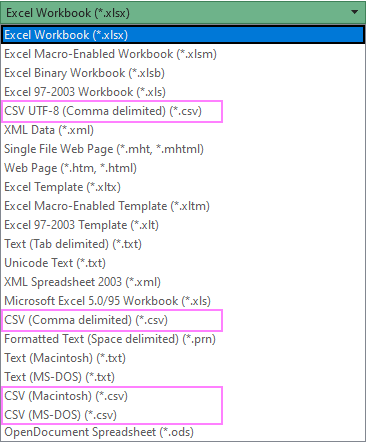
CSV (comma delimited). This format saves data in a comma-separated text file that tin be used in some other Windows programme or another version of the Windows operating organization.
CSV (Macintosh). This format saves a workbook as a comma-separated file for use on the Mac operating arrangement.
CSV (MS-DOS). Saves equally a comma-separated document for employ on the MS-DOS operating organization.
CSV UTF-8 (comma delimited). Information technology is Unicode Transformation Format 8-scrap encoding that supports many special characters, including hieroglyphs and absolute characters, and is backward compatible with ASCII. This format is recommended for files that comprise whatever non-ASCII characters since the classic CSV format destroys them.
Likewise CSV, there is one more format that may come in extremely handy for communicating with other programs.
Unicode Text (*.txt). This is a computing industry standard supported by almost all current operating systems including Windows, Macintosh, Linux and Solaris Unix. It can handle characters of about all modern languages and some aboriginal ones.
Note. Past strict definition, the CSV format implies separating values with commas. In reality, y'all may come beyond many other delimiters, a semicolon and tab beingness nigh common.
How to convert Excel file to CSV
When Excel data is to be transferred to another application such every bit the Outlook Address book or Access database, the easiest mode is to save your worksheet as a .csv file, and then import that file to some other program.
To save an Excel file (.xlsx or .xls) in the CSV format, here are the steps you need to follow:
- In your workbook, switch to the target worksheet as only the agile sheet volition be converted.
- On the File tab, click Save As. Or press the F12 cardinal to open the Save Equally dialog.

- In the Save Equally dialog box, pick the desired CSV format from the Save equally type driblet-downward bill of fare, On Windows, you'd choose either CSV (Comma delimited) or CSV UTF-8.
- Choice the destination folder and hit Save.
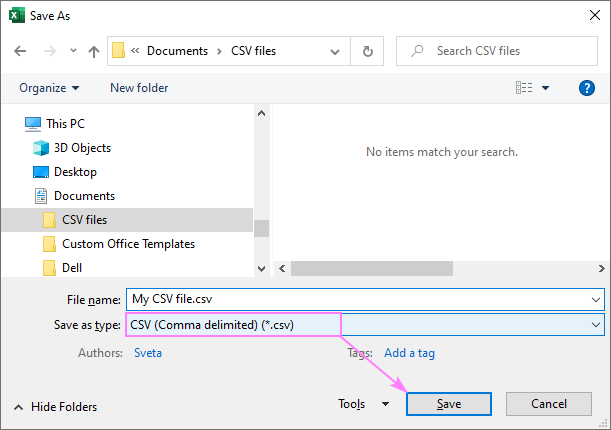
In instance your worksheet has whatsoever formatting, formulas, charts, shapes or other objects, you volition exist informed that some features in your workbook might be lost if you lot salve it every bit CSV (Comma delimited). If that is Okay, click Yes to complete the conversion without the unsupported features.

Export Excel to CSV without destroying special characters
If your spreadsheet contains some special symbols, smart quotes or long dashes (e.g. inherited from a Word certificate), foreign characters (tildes, accents, etc.) or hieroglyphs, the method described higher up won't work.
The betoken is the saving to the CSV (comma delimited) format distorts any characters other than ASCII (American Standard Lawmaking for Information Interchange).
To go along non-ASCII characters undamaged, a document should be saved to a format that uses a Unicode grapheme encoding. There exist two Unicode encoding forms: viii-flake (UTF-8) and 16-bit (UTF-16).
Before nosotros motility to the exporting steps, let us point out the cardinal features of each encoding, so you can cull the format right for a item case.
UTF-8 is a more meaty encoding since it uses 1 to 4 bytes for each symbol. Generally, this format is recommended if ASCII characters are most prevalent in your file because most such characters are stored in one byte each. Another advantage is that a UTF-8 file containing just ASCII characters has absolutely the same encoding equally an ASCII file.
UTF-16 uses 2 to 4 bytes to encode each symbol. Still, a UTF-16 file does not e'er crave more storage than UTF-8. For example, Japanese characters take iii to 4 bytes in UTF-8 and ii to four bytes in UTF-16. And then, you may desire to utilise UTF-16 if your information contains any Asian characters, including Japanese, Chinese or Korean. A noticeable disadvantage of this format is that it's non fully compatible with ASCII files and requires some Unicode-aware programs to display them. Please keep that in heed if you are going to import the resulting document somewhere exterior of Excel.
Once you've decided on the format, the below instructions will walk y'all through the process.
How to convert Excel to CSV UTF-viii
Suppose y'all have a worksheet with some foreign characters, Japanese names in our instance:
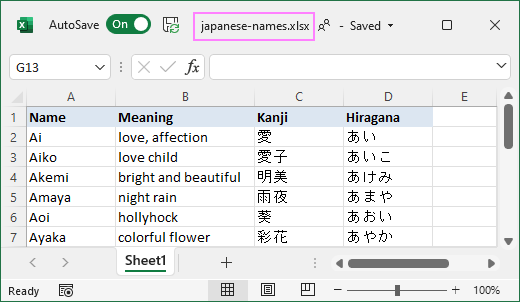
Depending on the Excel version you are using, it may accept 3 to 5 steps to catechumen this file to CSV keeping all special characters.
Export to CSV UTF-8 in Excel 2016 - 365
In Excel 2016 and later versions, y'all tin can save a file in the CSV format with UTF-8 encoding directly:
- In the target worksheet, click File > Save Every bit or press the F12 key.
- In the Save As dialog box, select CSV UTF-8 (comma delimited) (*.csv) from the Save as type drop downwardly.
- Click the Save button. Done!
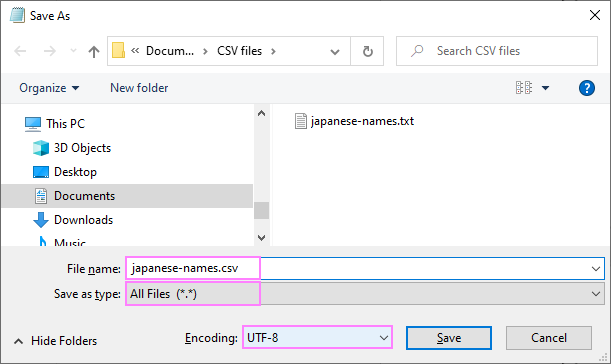
Convert to CSV UTF-8 in Excel 2013 - 2007
As older Excel versions do not support the UTF-8 encoding, you'll need to save your document in the Unicode Text format first, then catechumen it to UTF-8.
To export an Excel file to CSV and preserve special characters, follow these steps:
- In your worksheet, click File > Salvage As or printing F12.
- In the Save Equally dialog box, choose Unicode Text (*.txt) from the Save as blazon drop-downwards carte, and click Salvage.
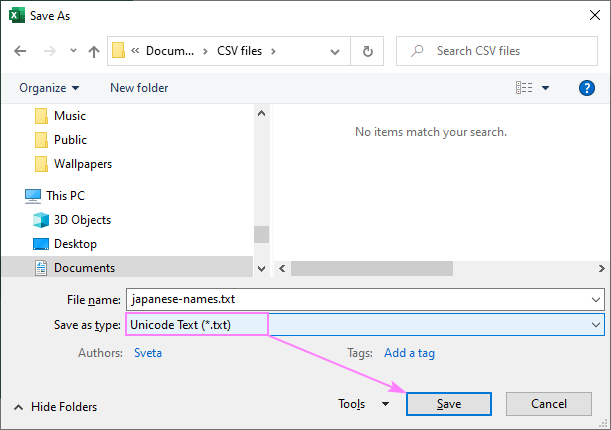
- Open the txt document using your preferred text editor, for case Notepad.
Note. Some simple text editors do not fully support all Unicode characters, therefore certain characters may be displayed as boxes. In near cases this won't touch the resulting file, and so you can simply ignore this or use a more advanced text editor such as Notepad++.
- Since the txt file is tab-delimited while we aim for a comma-separated file, replace the tabs with commas. Here's how:
- Select any tab graphic symbol, right click it and choose Copy from the context menu, or press the Ctrl + C key combination.

- Press Ctrl + H to open up the Replace dialog box and paste the copied tab (Ctrl + 5) in the Find what field. After you've done this, the cursor will move rightwards indicating that the tab is pasted. Type a comma in the Replace with field and click Replace All.
If y'all want a semicolon-delimited CSV, and so replace tabs with semicolons.

If all done right, your resulting txt file should look like to this:

- Select any tab graphic symbol, right click it and choose Copy from the context menu, or press the Ctrl + C key combination.
- In Notepad, click File > Save Every bit and practice three important changes:
- In the File proper noun box, change the .txt extension to .csv.
- In the Salvage as type box, pick All files (*.*).
- In the Encoding driblet-downwards menu, select UTF-8 with BOM.
When washed, click the Save push.

Tips and notes:
- The byte order mark (BOM) is a sequence of bytes at the showtime of a text stream that indicates Unicode encoding of a text document. In instance of UTF-8 with BOM, the sequence 0xEF,0xBB,0xBF signals the reading program that UTF-viii encoding is used in the file. The Unicode standard permits but does not require the BOM in UTF-8. Nonetheless, it is frequently crucial for correct UTF-viii recognition in Excel, especially when converting from Asian languages.
- If your text editor does not allow changing the file extension, y'all tin can do that in Windows Explorer.
Now, you can open the CSV file in Excel and make sure all information is rendered correctly:
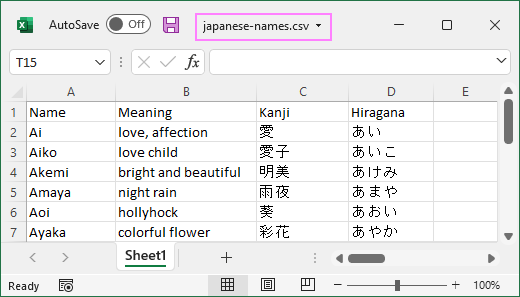
Notation. If your file is intended for use in another application where the UTF-8 format is a must, exercise not make any edits nor save the file in Excel as this may crusade encoding problems. If some data does non announced right in Excel, open the file in Notepad and fix the information in that location. Recall to save the file in the UTF-8 with BOM format once again.
How to convert Excel file to CSV UTF-16
Exporting to CSV UTF-16 is done very much the same manner equally to CSV UTF-8:
- Save the workbook in the Unicode Text (*.txt) file format.
- Open up the .txt document in a text editor such as Notepad and replace all tabs with commas.
- Change the file extension to .csv, brand certain encoding is set to UTF-xvi LE, and relieve the file.

Convert multiple Excel sheets to CSV
As already mentioned, Excel's Save Equally command is only able to convert an agile worksheet. But what if your workbook contains a lot of different sheets, and you wish to turn them all into carve up csv files? The only culling suggested past Microsoft is saving each sheet nether a different file proper name, which does non audio very inspiring, huh?

And then, is there a quick way to save multiple Excel sheets as CSV at one time? Yes, information technology can be washed with VBA.
The beneath code converts all worksheets in the current workbook to individual CSV files, i for each canvass. The file names are created from the workbook and sheet names (WorkbookName_SheetName.csv) and saved to the aforementioned folder every bit the original document.
Sub ConvertMultipleCSV() Dim ws Equally Worksheet Dim path Every bit Cord Awarding.ScreenUpdating = False path = ActiveWorkbook.path & "\" & Left(ActiveWorkbook.Proper noun, InStr(ActiveWorkbook.Name, ".") - i) For Each ws In Worksheets ws.Copy ActiveWorkbook.SaveAs Filename:=path & "_" & ws.Name & ".csv", FileFormat:=xlCSV, CreateBackup:=False ActiveWorkbook.Close Fake Adjacent Application.ScreenUpdating = True End Sub
Please keep in listen that the above lawmaking saves sheets in the CSV format. If there are any non-ASCII characters in your information, then you need to catechumen to UTF-8 CSV. This can be washed by changing the file format from xlCSV to xlCSVUTF8. That is, you replace FileFormat:=xlCSV with FileFormat:=xlCSVUTF8.
Also, remember that CSV UTF-eight conversions are possible in Excel 2016 and college.
The following guidelines will aid you with adding the macro to your workbook: How to insert and run VBA lawmaking in Excel.
Apart from the methods described above, there exist a handful of other ways to convert Excel sheets to CVS. Beneath, I volition share a couple of my favorite ones.
Excel to CSV via Google Spreadsheets
The utilize of Google Spreadsheets for .xlsx to .csv conversions seems a very simple workaround:
- In Google Spreadsheet, click File > Import.

- Click Upload and drag-and-driblet the file or select from your figurer, and and so click Import data.

Tip. If you take a relatively small dataset, it may exist easier to copy/paste information technology straight in the spreadsheet.
- Get to the File menu > Download > Comma-separated values (.csv, current sheet).
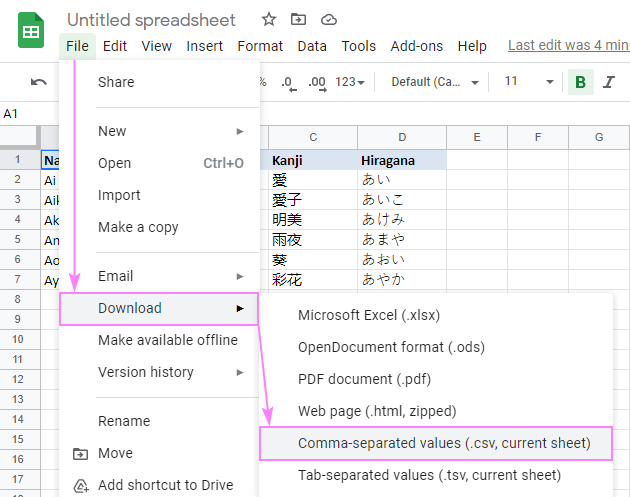
Open up the downloaded file in some text editor to make sure all the data is exported right.
Note. If your original Excel sheet contains special characters, the resulting CSV file may not display the characters correctly when opened in Excel, though it looks perfect in many other spreadsheet programs.
Save .xlsx to .xls and and then convert to .csv
This method of converting Excel to CSV hardly needs any further explanations because the heading says information technology all :)
I came across this solution on some forum, cannot remember which exactly. To be honest, this method has never worked for me, just many users reported that special characters, which got lost when saving .xlsx straight to .csv, are preserved if to relieve a .xlsx file to .xls first, and and then save .xls every bit .csv equally explained in How to convert Excel to CSV.
Anyway, you tin attempt this method of exporting Excel to CSV on your side and if it works, this can be a real time-saver.
Convert Excel to CSV using OpenOffice
OpenOffice is an open up-source suite of six applications. One of them is a spreadsheet app named Calc, which is really proficient at exporting spreadsheet information to the CSV format. In fact, it provides more options (encodings, delimiters, etc.) than Microsoft Excel and Google Sheets combined.
To catechumen your Excel file to CSV, follow these steps:
- Open up your Excel document with OpenOffice Calc.
- Click File > Relieve as… and choose Text CSV (.csv) from the Salve equally type drop-down menu.
- Next, yous volition be asked to define encoding and delimiters. If your goal is the CVS format that correctly handles special characters, then cull:
- Unicode (UTF-8) for Character ready.
- Comma for Field delimiter. If you need a semicolon-delimited csv file, then select semicolon (;) or any delimiter you want.
- Quotation mark for Text delimiter.
To complete the conversion, click OK.
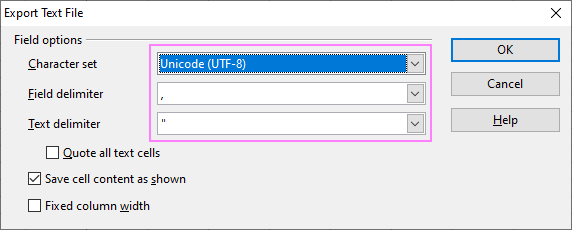
Information technology would be really nice if Excel provided similar options to perform fast and painless CSV conversions, wouldn't it?
These are the means of converting Excel to CSV I am enlightened of. If you know other more efficient methods, please practise share in comments. Thank y'all for reading!
You may as well be interested in
Source: https://www.ablebits.com/office-addins-blog/convert-excel-csv/
Post a Comment for "C How to Read X Amount of Numbers Seperated Bt Spaces"